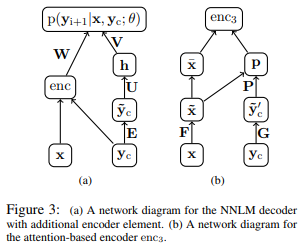A Neural Attention Model for Abstractive Sentence Summarization (Rush et al. 2015)
Overview
-
Given the first sentence of an article as input, this model generates a suitable headline for the article
-
It trains attention based neural network to generate language model
- Given the entire input sentence and the contexts of the output, the model generates the subsequent word for the headline
Key Results

-
Architecture of the entire model (left section of the diagram)
-
One hot representation of all words in the input sentence and the context words (in the headline) are processed in the attention based encoder to generate their encoded representation.
-
One hot representation of context matrix are multiplied by their embedding matrix E to be generate their embedded representations.
-
Embedded context matrix is multiplied by the weight matrix U, and the result subsequently undergoes non-linear transformation (tanh) to generate its hidden representation h.
-
Encoded representation from step 1 and the hidden representation h from step 3 are multiplied by their corresponding weight matrices, and the exponential of their summation is used to estimate the probability of the language model
-
-
Architecture of the encoder (right section of the diagram)
-
One hot representation of all words in the input sentence and the context words are multiplied by their corresponding weight matrices F and G to generate each of their hidden representations
-
Embedded input matrix representation and context matrix representation are multiplied by the weight matrix P to generated the additional hidden representation p.
- The weight matrix P can be regarded as learning the alignment between the words in the input sentence and the words in the context (Attention Mechanism)
-
Hidden representation p and the embedded input matrix are multiplied to create encoded representation of the input that incorporates the attention mechanism
-
-
Once the language model is trained, it is combined with other hand engineered features to predict the subsequent word of the headline
-
Weights between the language model and the hand engineered features can be additionally trained
Comments
-
Instead of encoding the sequence of entire sentence using a single neural network, it might be better to use other forms of deep learning such as RNNs.
-
Most of the hand engineered features are based on sequential information (such as the presence of unigram, bigram, trigram match)
-
Sequential deep learning models might be able to remove these additional hand engineered features.
-
Instead of sentence summarization, I wonder if it is possible to apply similar attention based methods to generate a summary that contains multiple sentences.